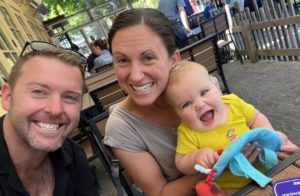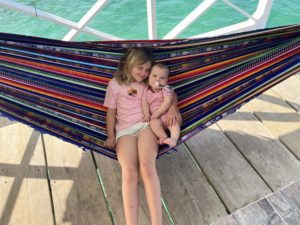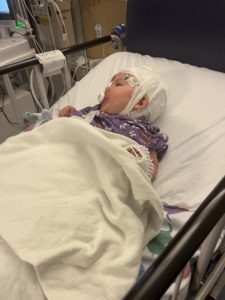Zach and Geri Landman are devoted parents and physicians – a pain specialist and pediatrician, respectively – committed to making the world a better place for those around them. They are also rare parents; their daughter Lucy, now 14 months old, was diagnosed with an ultra-rare disorder called PGAP3. Currently, there are fewer than 50 known cases of PGAP3 worldwide. Unfortunately, this means that there are no available trials and a limited amount of clinical research taking place.
Determined to cure their daughter – and to help other families affected by single-gene disorders – the Landman family founded Moonshots for Unicorns, a 501(c)(3) nonprofit organization. Since its launch, Moonshots for Unicorns has connected with many different scientists and researchers, partnered with the Jax Center for Precision Genetics, and began working towards an AAV9 gene therapy solution.

Recently, I sat down with Zach and Geri to discuss PGAP3, the diagnostic journey, Moonshots for Unicorns, and how they believe gene therapy has the potential to significantly and positively impact the rare disease community.
What is PGAP3?
PGAP3 is a congenital disorder of glycosylation; you may also see it written as PGAP3-CDG. This ultra-rare disorder is caused by PGAP3 gene mutations. It is inherited in an autosomal recessive fashion, meaning that those with PGAP3 inherit two defective genes.
The Rare Diseases Network explains that PGAP3 is characterized by cognitive impairment and hyperphosphatasia. Other symptoms and characteristics can include:
- A short nose with a broad nasal bridge and tip
- Hypotonia (low or weak muscle tone)
- An unsteady gait
- Poor balance and coordination
- A lack of muscle control
- Sleep disturbances
- Constipation
- Gastroesophageal reflux
- Speech and vision problems
- Developmental and intellectual delays
- Epilepsy
You may also learn more about PGAP3-CDG through Moonshots for Unicorns.
Lucy’s Story
When they learned that they were expecting Lucy, Zach and Geri were thrilled. They have two other daughters and were excited to expand their family. However, the 11-week ultrasound showed something concerning: abnormalities in Lucy’s posterior fossa. Increased fetal testing – including five ultrasounds, a fetal MRI, and amniocentesis with chromosome testing – came back relatively normal, so the family and doctors felt reassured.
Other potential concerns began appearing after Zach and Geri brought Lucy home. Geri explains:
During the first two weeks, she was on the super sleepy end of the spectrum, but that normalized. Around four months old, she began showing interest in food. When I tried to sit her in her chair to try some food, she just sort of flopped to the side. The same thing happened at five months.
Eventually, Geri and Zach took Lucy to a neurologist and began physical therapy. They were told that she had benign congenital hypotonia but would most likely outgrow it. And, through physical therapy, that appeared to be the case. Lucy was sitting independently and always had a great time playing with her older sisters!

When Lucy was 8.5 months old, her family took a trip to Panama. Lucy has always loved the water, so spending her vacation with her mom by the pool was sure to be a lot of fun. But she got a minor virus while traveling, and something started to seem very “off.” Lucy was tired and fussy; she didn’t want to play in the pool. As Geri explains:
Previously, she’d been sitting up for 15 minutes. During this trip, she was suddenly falling over and hitting her head. She stopped making eye contact and eating solid food. Luckily, we came home the next day. We messaged with her doctors and eventually went to the emergency room at Lucille Packard Children’s Hospital. But nothing was found.
As a pediatrician, I know that there’s a lot to be anxious about out there – but that’s higher than the actual prevalence of rare diseases. I found myself often grappling with my own anxiety looking at this baby in front of me who sometimes looked fantastic and other times seemed like she was falling off of a cliff.
The PGAP3 Diagnosis
Zach and Geri kept moving forward; they wanted to figure out what was happening with their daughter. They kept sharing their concerns with their neurologist, who eventually brought Lucy in for an extensive panel of tests: a full MRI, 30-hour EEG, EMG nerve conduction study, and spinal tap. These were all normal and nothing seemed to explain what was going on. Then a neurogenetecist named Dr. Maura Ruzhnikov – who happened to be Geri’s resident when she was a medical student! – decided to send out a 485-gene panel to see if there were any underlying genetic causes.

April 18 – the day of diagnosis. After receiving a text message about concerning genetic results, Zach and Geri went home to have a Zoom call with Dr. Ruzhnikov. The genetic reports stated that Lucy had a variant of unknown significance in one PGAP3 copy and a pathogenic mutation in the other. Zach shares:
We were told that there was a 75% likelihood of PGAP3 being her diagnosis, and that we needed to get tested as well. When we asked what this meant for Lucy, we were told that she’d likely never walk, she’d likely never talk, she’ll be severely intellectually disabled, and she’d likely develop seizures in childhood. At first, we didn’t want to believe it. Denial is a powerful thing and we had Lucy in front of us, smiling and laughing.
But despite the strong feelings of denial, Zach and Geri trusted their doctor. They stayed up and read all night. Geri says:
That was the start of us not sleeping anymore. I think together we read every paper ever published on PGAP3. By the next morning, we knew that she had it. Testing was able to confirm that we’re both carriers for her copies. We spent about a week really mourning the diagnosis, our hopes and dreams for Lucy, and the reality of what will likely happen to her.
After processing, Zach and Geri knew that they had two options. They could accept that this was what was happening or they could try to do something to change the course of Lucy’s life – and the lives of every other child with PGAP3.
They chose the latter.
Making a Change for PGAP3
On April 18, there were no translational research organizations, advocacy organizations, or treatment options for PGAP3. The only thing that Zach and Geri could find was a Facebook group with around 12 families whose children have PGAP3, a form of Mabry syndrome. So they began to reach out to researchers. Zach explains:
Having been trained in medicine, Geri and I are able to read and understand scientific studies very well. We began emailing the first and last authors of every research paper on PGAP3 to see if we could connect. People are so generous, kind, and thoughtful with their time. Dr. Yu at Harvard had his lab analyze Lucy’s gene. Geri also connected with Dr. Kathrin Meyer at Nationwide Children’s. After analyzing Lucy’s gene, she said that gene therapy would be an excellent fit. It’s going to take over $2,500,000 and two years, but she is ready and willing to get started.
During their searches, Zach and Geri also learned about Dr. Ethan Perlstein. Dr. Perlstein had previously worked with another family whose daughter Maggie had a similar single-gene disorder. He repurposed a Japanese nerve pain medicine which boosted the necessary protein Maggie needed by 400%. Through this treatment, Maggie began to walk and talk on her own. Zach and Geri were inspired by this. Since connecting with Dr. Perlstein, he has now begun helping them with their mission.
Join us in Part 2 as we discuss Moonshots for Unicorns and its main focuses, the plan moving forward, and the power of diagnoses.






